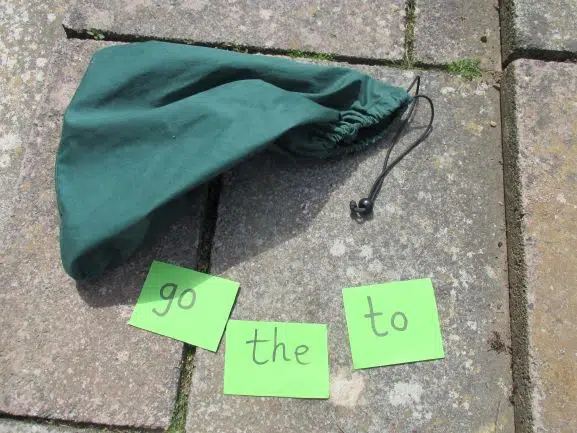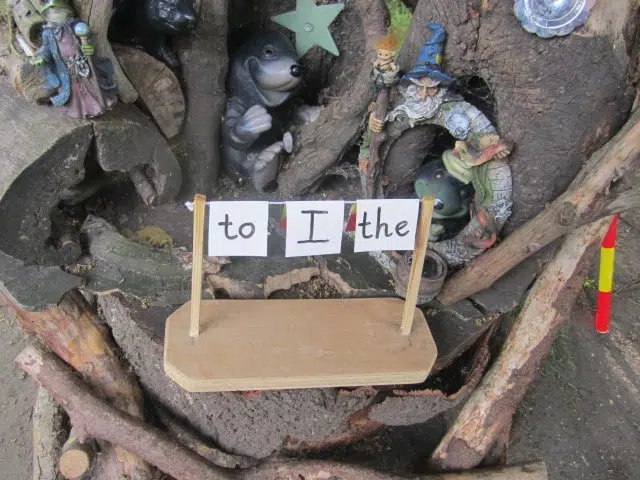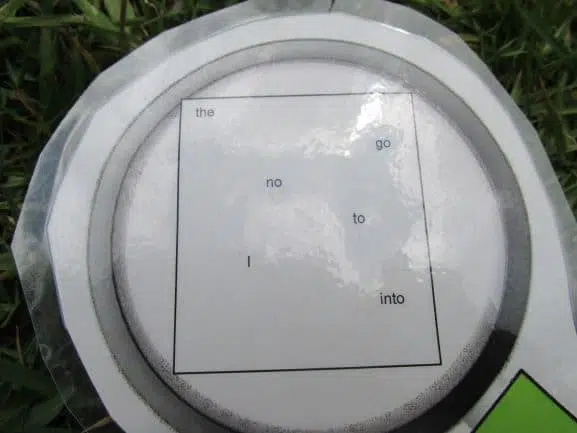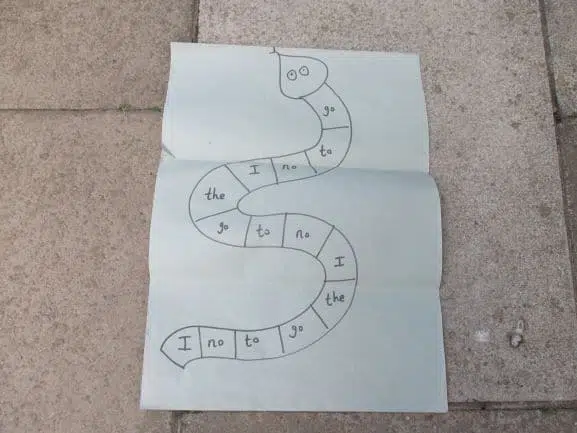‘Tricky’ words are not tricky because they are hard! That’s the most important thing to understand.
Many children have put them off because they think they are difficult, as well as there are some parents who don’t want to practice them with their children because they sound intimidating.
‘Tricky’ words are called that because you can’t sound them out. That’s all there is to them!
So, in short, what is a ‘tricky’ word? And what makes words tricky?
A ‘tricky’ word is one that cannot be sounded out. They are words that are non-phonetic. If you sound tricky words out and then try to blend the sounds, you will get a word that does not sound right. They are words that must be recognized by sight.
If that sounds slightly confusing, in a moment I will go into this in greater depth to make things as clear as possible.
Also, many people have lots of other questions like how do you teach tricky words? What games can you play? When should you start learning tricky words? What order do you learn them in?
I will answer all of these questions for you in this article, and hopefully set you up for success in teaching ‘tricky’ words to children.

What Tricky Words Are
‘Tricky’ words are non-phonetic.
Some languages have more words that are non-phonetic in them than others. Italian, for example, is almost entirely phonetic. However, English has a much greater balance between words that you can sound out and words that you can’t.
Therefore, when early readers try to learn English, they need to be able to use phonics to read many words, but also to memorize many English words by sight as well (sight words). There are two skills that combine to help them read all the available words.
Tricky words are these words that need to be memorized, for the simple reason that if you sound them out it doesn’t sound right.

An example is the word ‘be’. If this was written phonetically, it would be written as ‘bee’.
However, if children try to sound out ‘b’ and then ‘e’, they would then blend the word ‘beh.’
All tricky words are like this! They are tricky because you can’t sound them out – it’s that simple!
What Is Sounding Out Words?
Early phonics works by children sounding out words. For example, the word ‘dog’ can be broken into three sounds (or phonemes) ‘d-o-g.’ (If you want to find out what phonemes are in more detail, then check this out.)
They then ‘blend’ the sounds to make the word ‘dog’. Blending is basically merging the sounds together to make a word.
To find out the full lowdown on what blending in phonics is, then check out this article.
For most words in simple texts, young readers will be able to use this method of sounding out each word. ‘Tricky’ words are the exception. You’ve just got to sight-learn them.
What Are The Tricky Words?
The tricky words are usually taught in an order. Though this differs from country to country, and also across different reading schemes within those countries, this is roughly the order to go for:
I , no, to, the, go, into
he, she, we, me, be, you, are, her, was, all, they, my
said, have, like, so, do, some, come, were, there, little, one, when, out, what
These are the main ones to learn certainly within the first year of learning phonics (though some children will take longer than this).
High-Frequency Words Vs Tricky Words
There are similarities between high-frequency words and tricky words, but there are also differences.
First, the similarities:
- Some high-frequency words are ‘tricky’ words. (However, there are many that are not)
- It is good to be able to just sight-read both
- They are taught in the order of their frequency in English. For example, the word ‘the’ is one of the most common words, and is also one of the first to be taught
Now the differences:
- The main difference between high-frequency words and tricky words is that some high-frequency words can be sounded out. Examples are ‘is’, ‘it’ and ‘and’. However, it is best if children can just read them without sounding out if possible. Phonics is just a stepping stone to word recognition. The more speed and fluency children can get into their reading, the better
- High-frequency words can become sight words. Sight words are words that you read without decoding. However, ‘tricky’ words are always sight words.

When To Start Teaching Tricky Words
To successfully teach tricky words, it is definitely worth teaching them at the right time.
I think it is important to wait until the following are true:
- Children know quite a few phonemes. It is best to let them learn lots of these as a warm-up for recognizing full words (which is quite a bit harder).
- Children should be able to sound out words and understand how this works (Even though this is not a skill required for ‘tricky’ words, they need to know how normal phonetic words work before going on to the variation.
- It is best if children are at least beginning to blend. They need to have experience and knowledge of what phonetic words are first, before you then go and muddy the waters a bit by adding in words that work differently. In an ideal world, they would probably be able to blend three-letter words independently, but even if they are just starting to do this, they have a much greater chance of reading ‘tricky’ words.
When these things have both happened, your early readers are now ready and rearing to go with learning ‘tricky’ words. But how do you introduce them?
How To Introduce Tricky Words
The classic way to introduce ‘tricky’ words is the following:
- Show the word and say it
- Put the word into a sentence. Then put it into another sentence
- See if the children can put the word into their own sentences
- Practice reading the tricky word in a simple caption
- Practice writing the tricky word
- The next day, refresh their memory by showing the word again, while adding another word to their repertoire
- Keep their memory fresh by showing more tricky words using flashcards and in different fun ways
So, to teach the word ‘she’, it might go something like this:
- Show ‘she’ and say it
- Put it into a sentence, e.g. ‘She went on the bus.’
- The children make up sentences, e.g. ‘She is going to the zoo.’
- Write ‘she’
- Read ‘She is a cat.’
That’s pretty much all there is to tricky words. Just repeat this process every time you teach a ‘tricky’ word.
Adult-Led Games To Teach Tricky Words
The big thing is to regularly practice ‘tricky’ words. The more good-quality practice you do, the more fluent the children will get.
The big problem is making this enjoyable.
‘Tricky’ words can be a bit boring! If you just show flashcards with ‘tricky’ words on them day after day, many children will switch off.
Luckily, there are lots of fun games you can play to jazz this process up and keep them interested.
To start with, here are a few adult-led games that you can play, to get them enjoying the process:
1. Spy Game
Spy games are always a winner. Children love the element of secrecy and surprise!
This is really simple. Show the children some flashcards of ‘tricky’ words, and they whisper the words in their best ‘spy voice’ to the person sitting next to them. Simple but great fun!
2. Round The Circle
This is probably my number one ‘tricky’ word game, and if you play no other, I would definitely play this one.
The children sit in a circle. Have a pack of ‘tricky’ word cards once again.
Pass one card with a tricky word written on it to the first person in the cirle. They say the word, then pass it to the next person. That person also says the word.
Keep passing the word around the circle, and everyone says it when the hold it.
Get more cards on the go at the same time. In the end, you want loads of cards going around the circle.
This game has loads of advantages, including:
– It is repetitive, and you get loads of goes of saying the new words
– Even if you don’t know the words, you can listen in to the person next to you and try to pick some up
– For those who know the words, it is a good game for developing your speed and fluency
3. Speed Challenge!
Having an element of speed in games is great for competitive children.
For this game, you just need a timer (probably 30 seconds is good) and a pile of flashcards.
Sit the children in a circle. The idea is to turn the timer over, and they have 30 seconds to successfully pass every single word around the circle once.
4. Different Voices!
This one is like a glorified version of showing flashcards.
You show the flashcards to the children, and they say them in different voices! For example, you could say them like a ghost! Or an alien, or a zombie, or a princess.
Say a few words at a time in one voice before switching to another. This really keeps their focus and attention.
This game is also brilliant for developing early counting, and you can read about this and many other strategies in this article.
Play-Based Games To Teach Tricky Words
As well as being lots of fun adult-led games you can do, there are also games that children can play by themselves.
Here are some excellent examples that you can have a go of:
1. Secret Hunt
Children love anything to do with detectives and top-secret missions.
The more you can get these into what you do, the better.
In this secret hunt game, all you need is some small cards with tiny tricky words written on them. Put these around the room. Hide them under tables, at the sides of cupboards, on chair legs – wherever you can think of.
Then give the children some magnifying glasses. They are the top-secret detectives!

They simply go around the room, try to find the mini-words, and try to read them. Hours of fun!
2. Board Game
This is really simple to set up. You make a board game that will look something like this:

You could use a snake, a rocket, or a caterpillar – anything like that which you can split into sections and put words on.
Select a few ‘tricky’ words to go on the sections. It is good to target the words you are trying to learn at that time. You could have anything from about two words to perhaps six or seven.
This is a good game for anywhere between 2 to 6 children.
Each child playing has some kind of counter. It could be a differently colored Lego piece each, for example.
They put these at one end of the board.
Now the first child rolls the dice and goes that number of steps up the board. They try to say the ‘tricky’ word that they land on.
Then the next child goes, and so on. The winner is the child that gets to the end first.
3. Snap!
This is like the classic card game.
All you need for this is a pile of lots of tricky word cards. You could have two players, or you could have a few more (maybe four might be the sensible limit for this game).
Split the tricky words between the players, and then one person puts down a card first in the middle of the table (and says the word). Then another player puts their card down and says that one.
Just like a normal snap, whenever two cards match shout ‘snap!’ and put your hand on the deck. Whoever puts their hand on them first wins all the cards. The winner of the game is the person who ends up with all the cards (or most if you have to finish in an agreed time).
If you like the sound of some of these games that I’ve listed here, then I’ve written an even more in-depth article about the 12 best ‘tricky’ word games that you can read here.
Common Mistakes about Tricky Words (And How To Resolve Them)
There are quite a few issues that will crop up when you try to teach tricky words, and there are different things you can do to address these things.
Some of these include:
Children Try To Sound Them Out
This is the most common problem you will encounter. Children get used to the process of sounding out each when they read a sentence, and continue this process even when there is a tricky word in it.
You will often find that many children will know multiple tricky words when read in isolation but put them into a sentence, and the child will not recognize them at all, or at least try to sound them out first.
The key to this really is practice. There is no easy way around it. Some children will just ‘spot’ the tricky words they know much quicker, and some will take longer.
The more you can develop their sight-speed fluency, the quicker they will transition to sounding out some words and recognizing others.
They Cannot Remember Them
Some children find ‘tricky’ words much harder than phonetic words. It is, for them, a much harder skill to recognize a whole word, as opposed to just a phoneme.
The thing here is to make it multi-sensory. The more action, dance, movement, and song you can get into the teaching of ‘tricky’ words the better. This activates many more parts of the children’s brains and gets them much more strongly engaged.
You could also think about playing memory games, such as the 22 fantastic ideas that I wrote about in this article.
They Don’t Use Them In Writing
Some children will learn to be able to read the ‘tricky’ words just fine. They may even be spotting and reading them in sentences.
However, these same children may just write completely phonetically.
For example, they write ‘too’ instead of ‘to’, ‘mee’ instead of ‘me’, and ‘thai’ instead of ‘they.’
Again, this is normal, and just a process that they go through. The more practice they have of writing tricky words in isolation, the more chance they will have of recognizing when a word is ‘tricky’ when they are writing.
Top Tips For Teaching Tricky Words
- Teach them in order
- Start when children are at least beginning to blend and know lots of phonemes
- Practice them daily
- Use fun games and bring the process to life!
- Practise and apply the skill in different contexts
Conclusion
Certain words are tricky. But ‘tricky’ words are not hard, I promise you! They just can’t be sounded out.
Making them fun is the big challenge, and lots of good-quality practice will get children confidently reading and learning many tricky words.
If you’ve found this article useful, then check out one of these…
